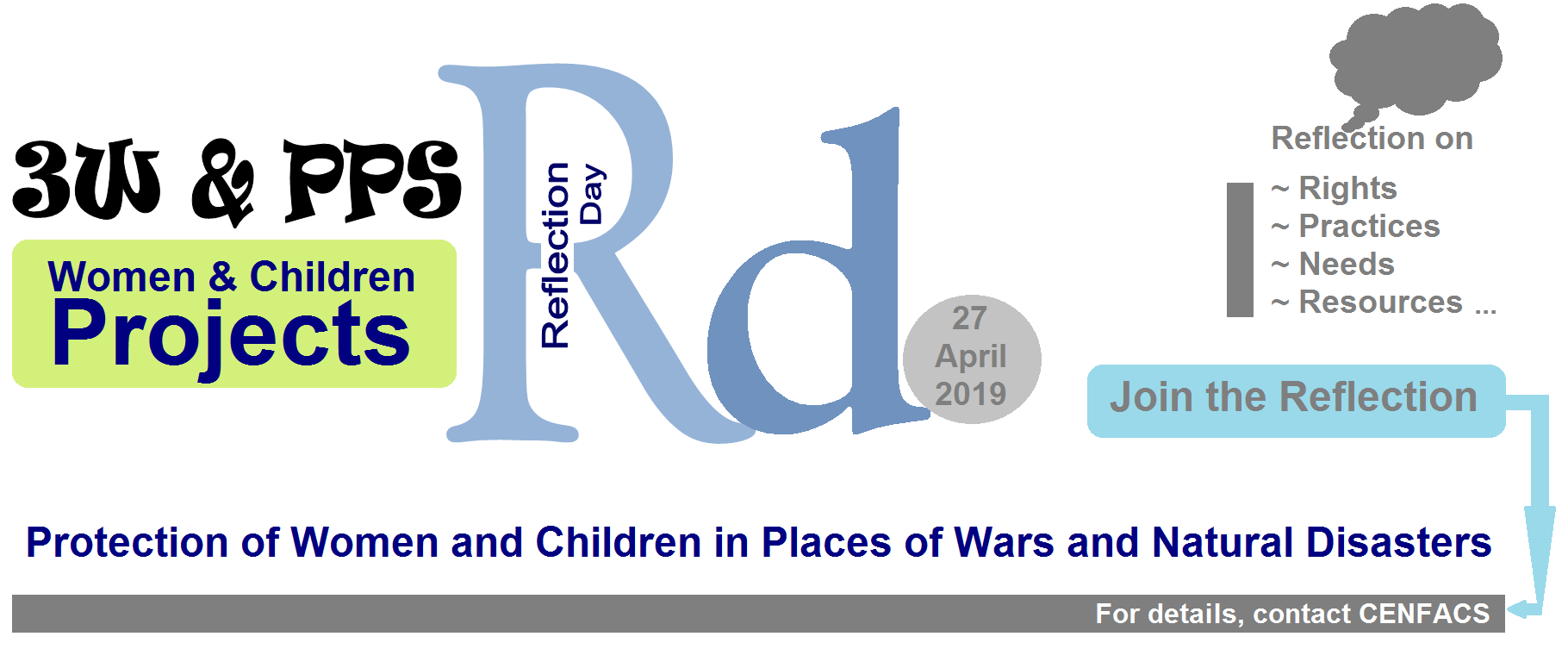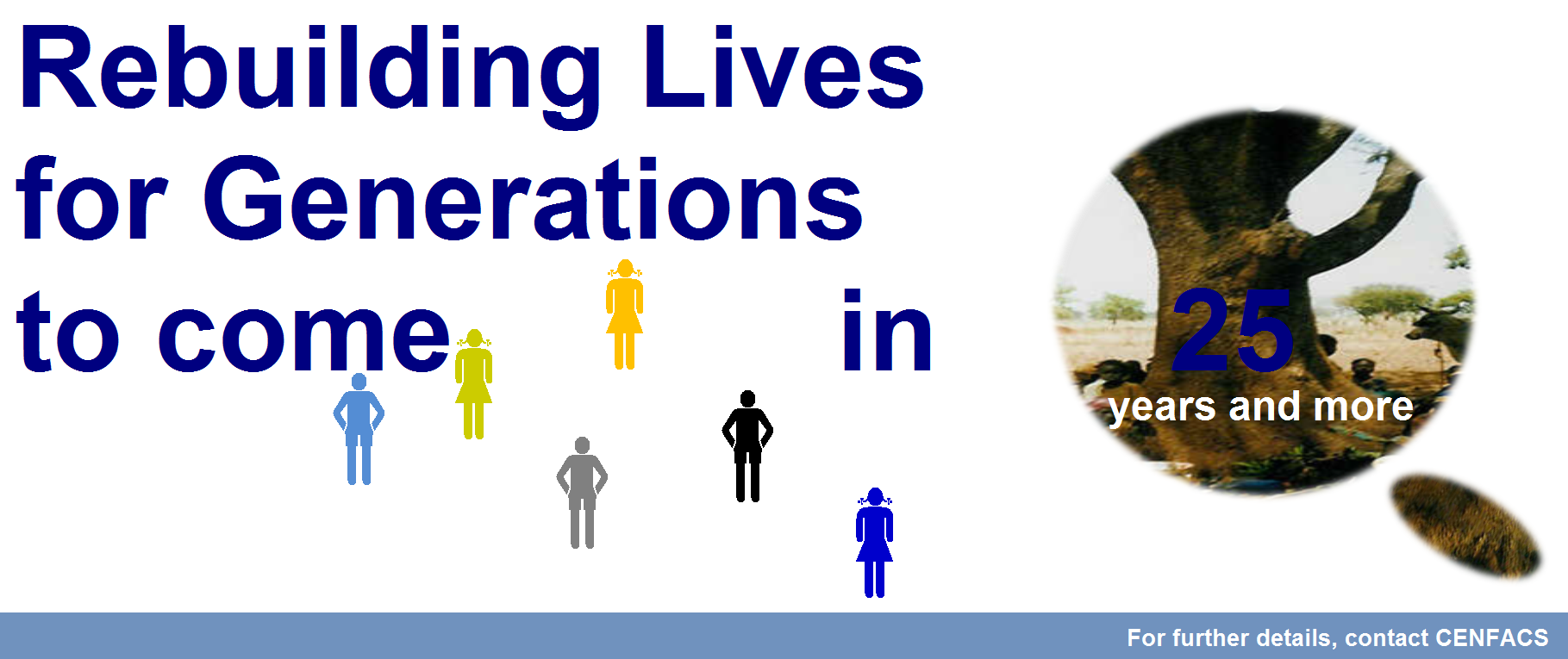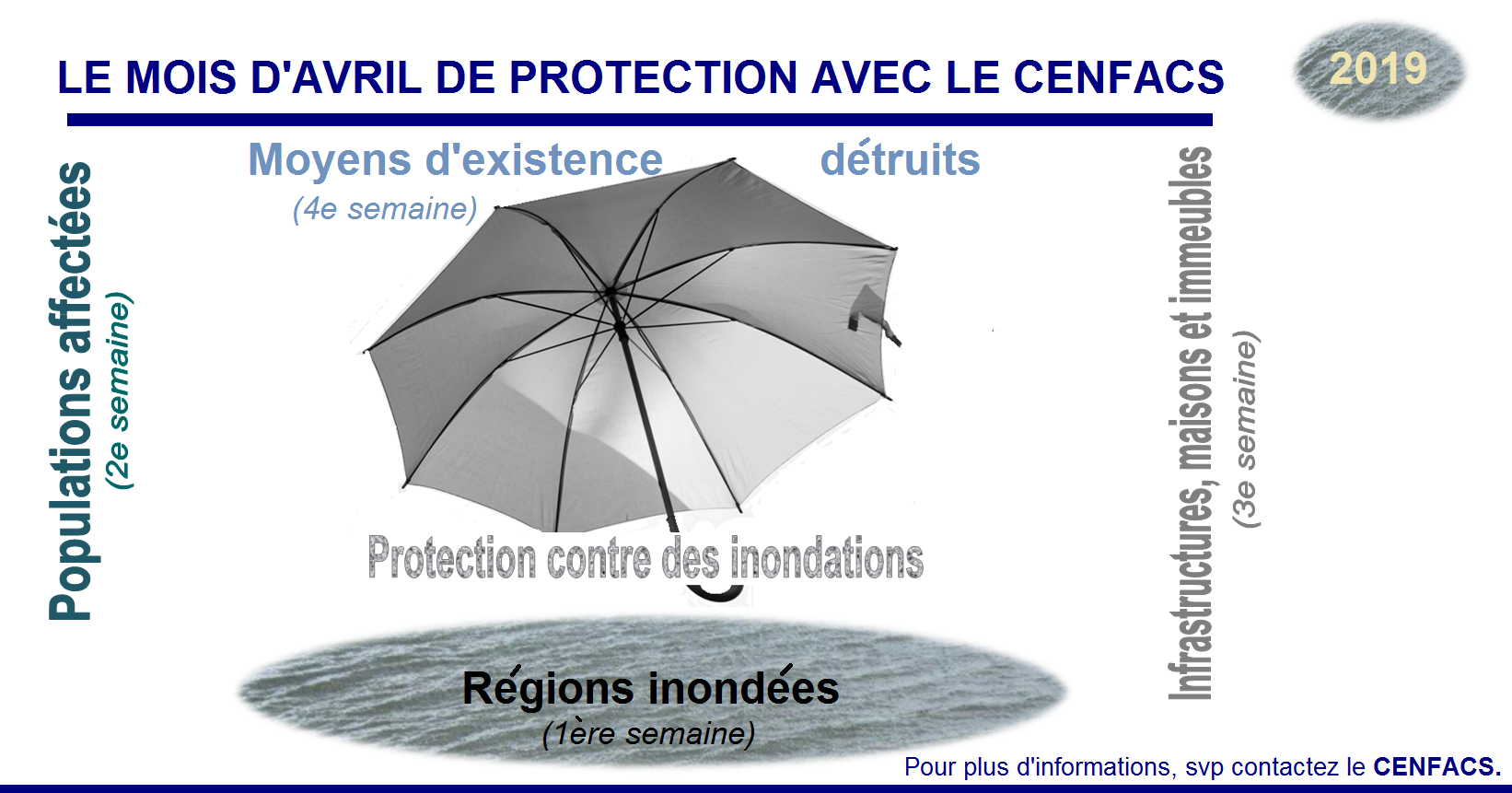Welcome to CENFACS’ Online Diary!
24 April 2019
Post No. 88
The Week’s Contents
• Reflection Day (27/04/2019) – In Focus: Protection of Women and Children in War-torn Zones and Natural Disaster-stricken Areas
• Protection of Sustainable Livelihoods: Week Beginning 22/04/2019
• Rebuilding Shattered Lives for Future Generations
… and much more!
Key Messages
~ Reflection Day (27/04/2019) on Protection of Women and Children in War-torn Zones and Natural Disaster-stricken Areas
To stay in tune with the theme of renewing lives in the Spring Relief season, this year’s Reflection Day, which will be held on 27 April 2019, has been planned to take into account the conditions and needs of women and children victims of and/or living in war-torn zones and natural disaster-stricken areas, particularly but not exclusively in Africa.
Events like destructive wars and natural disasters can affect everybody who gets caught by them. However, because our Reflection Day is about women and children, we need to pay a particular attention to them when it comes to dealing with these events.
To get the full extent of the first key message, please continue to read under the Main Developments section of this post.
~ Protection of Sustainable Livelihoods
The last of note about the theme of protection for this month is the Protection of Sustainable Livelihoods and other local lives from floods.
As part of this note, we are examining the linkages between sustainable livelihoods and the need for floods protection, between sustainable livelihood systems and protection systems related to a flood situation.
Through this concluding note, we will go beyond the narrow satisfaction of protection of basic needs by embracing sustainable livelihoods.
More on this second key message can be found under the Main Developments section of this post.
~ Rebuilding Shattered Lives for Future Generations: “Quadranscentennialisation” of Rebuilding
Our appeal for rebuilding lives (which you can find one specific example of rebuilding lives on our support page of this website) continues this week with a focus on rebuilding shattered lives for generations to come.
Rebuilding for Generations is about integrating inter-temporal and inter-space dimensions in our rebuilding projects or activities. We want to help rebuild current destroyed lives. If we want a lasting impact of our rebuilding help or work, then we need to think of temporal dimension (a t-dimension) or to integrate future generations in our model, plan, programme and project of rebuilding lives. In other words, we want our rebuilding work tackles inter-generational poverty. We don’t want to see the people we are helping to day in our rebuilding efforts, their children fall into the same poverty trap in the future.
As we are in CENFACS’ Q Year, we could even “quadranscentennialise” our rebuilding efforts by either going back 25 years from 2019 and integrate the time element of minus 25 years. Then, we could look at our rebuilding efforts backwards (minus 25) and what they have produced.
If, on the contrary we look at our model of rebuilding in the next 25 years (that is adding 25 years), we can integrate 25 years to the same model of rebuilding lives. Then, it will become Rebuilding plus 25. Rebuilding plus 25 can tell us what we are trying to rebuild today will it help the generations to come in 25 years? Our t-dimensional model can tell if what we are doing today in 2019 in terms of rebuilding will be relevant for the next generations after 25 years.
For further details on the “quadranscentennialisation” of rebuilding lives, please contact CENFACS.
Extra Messages
~ Q Project – Act No. 1: Thanks
Thank you for those who supported the first Act, the Protection Act, of the Q Project and Year. The Protection Act was about the Historical Survey of CENFACS’ Protection Work. It has emerged from this Act that a great deal of history making at CENFACS was done through protection work. Protection was central in what was done and continue to be a pivotal piece in CENFACS’ work today. Sustainable protection supports CENFACS’ aims and objectives of working with local people to develop sustainable initiatives.
Many thanks!
~ Q Protection questionnaire
As we told you last week, there was a basic questionnaire to complete after 19 April 2019 in order to support the historical survey about CENFACS’ protection work. This questionnaire, which is just a research instrument of the survey, is related to the six trends or dimensions of protection as shown in the Table no. 1.
The purpose of this survey is to collect information to assist CENFACS to improve its protection work as well as to research on the “quadranscentennial” legacies of CENFACS’ protection work.
So, our research frame of collecting information from stakeholders, users and other supporters through a questionnaire (online and in print) continues this week. At the end of this collection process, we shall look at the data collected and analysed them for learning and development purpose.
To participate and or support our historical survey of CENFACS’ protection work, contact CENFACS.
~ Easter Break ad Holidays Moments & Experiences to Remember, Share and Report
Now, some of you are back from Easter Break and Holidays, it could be a good idea to think of sharing and or reporting about your experience regarding life-renewal or just about Easter Break.
Sharing your experience in this way helps to build a collection of memories and experiences about life-renewal which everybody can draw from and improve learning and development. Furthermore, it helps empower others (those who need life-renewal examples) on the road to reducing poverty linked to the lack of life-renewing models.
As we said it in our previous communication, you can add photos, videos, audio materials, graphics and any evidence you think is useful to your life-renewing messages.
To share and or report on your life-renewal experiences or moments, please contact CENFACS.
Main Developments
• Reflection Day, 27 April: Protection of Women and Children in War-torn Zones and Natural Disaster-stricken Areas
Floods, droughts, storms and other natural disasters can cause a lot of damages, deaths and injuries as well as enormous financial costs. They can create climate refugees. They can cause all kinds of victims (humans, animals, buildings, assets etc.).
Amongst these victims are women and children. Women and children have to be moved, relocated and supported to rebuild their lives sometimes in the new locations or environments.
Likewise, wars especially destructive ones create victims as well. Amongst these victims are humans, animals, buildings, infrastructures and so on. Focusing on two particular victims from parties in armed conflicts are women and children.
Women and children victims of or living in war zones can greatly suffer from access to safe drinking water, medical care, shelter, education, protection etc. They can be displaced and their human rights can be derided or violated just as they can be exploited in many forms.
They have been a lot of truly documented stories of women harm and child causalities; stories reported in places of wars like in the Democratic Republic of Congo and in places of natural disasters like in Haiti.
Women and Children living in places of wars and natural disasters face an incredible amount of challenge for their life survival, let one their security to be alive.
This is why we need to think again the way in which women and children, especially the vulnerable ones, are protected in places of wars and natural disasters. This is because in the places like these ones, the fences of protection could have been destroyed by the events. Besides the urgency of meeting for example the basic needs of food, water, shelter and education; the need of protection could even challenge the possibility of meeting the other needs.
The Reflection Day will be about thoughts on how women and children can be best protected in places of war and natural disasters; places where there is a great challenge for protection as most of the safety and security nets have been destroyed or damaged.
Our Reflection Day will go in depth not only to explore life-saving strategies, fixes and enhancements to tighten the fences of protection; but also to engineer ideas for solutions to the root causes of the lacks of protection and security.
To proceed with our Reflection Day, we are going to have three areas of reflection:
1/ Thoughts on Women and Children protection rights and practices in places of war
2/ Thoughts on Women and Children protection rights and practices in areas of natural disaster
3/ How women and children can protect themselves rather than how somebody else protects them, in the two places. In this respect, one can think of self-protection and self-empowerment for protection.
Although our Reflection Day will be on women and children victims of war and natural disasters, we shall also extend our thoughts on women in combat mission, female soldiers, women and children detainees, women journalists and reporters in places of wars and natural disasters, child soldiers etc.
To support or join the Reflection Day on Protection of Women and Children, please contact CENFACS.
Below we have provided a timeline about CENFACS’ Reflection Day for reference.
• • Reflection Day Timeline
The Reflection Day is a day of thoughts by bringing together the two pillars of our network and protection programme, which are 3W and PPS. Although they started in 2003, we only introduced a Reflection Day (RD) in them in 2011.
In 2016, we amalgamated 3W and PPS to become Women and Children projects as we noticed in some situations it was difficult to separate women’s and children’s needs. Where their needs are separable or differentiated one to the other, we run either of the two brands (that is 3W and PPS) individually. This is why these two brands of our network and protection are still alive despite their amalgamation.
The Reflection Day is a day of introspection to think in depth the ways forward for our systems of support network and protection for poverty relief and sustainable development in face of the current, new and emerging challenges ahead as well as the changing development landscape.
Since its inception, the following is the timeline of 3W and PPS
2011: Making Networking and Protection Even Better in 2011
2012: Raising Standards in Poverty Reduction for Improving Lives
2013: Place of Women and Children in the Post-2015 Development World (Part I)
2014: Women and Children in the Post-2015 Sustainable Development Agenda (Part II) – A Stock Taking Reflection Event
2015: Doing Business to Lift Women and Children out of Poverty
2016: Improving Digital Protection for the Extremely Digitally Poor Women and Children
2017: Reducing Information and Communication Poverty for Multi-dimensionally Poor Women and Children
2018: Making Transitional Economy Work for Poor Families
For your information,
3W & PPS = Support Network and Protection for Poverty Relief and Development
Women and Children projects = amalgamation of 3W and PPS in 2016
3W (What Women Want) = a CENFACS support network scheme to enhance the lives of multi-dimensionally deprived women and families.
PPS (Peace, Protection & Sustainability) = a CENFACS child and environmental protection programme to support multi-dimensionally vulnerable children, young people and families
KNA (Keep the Net Alive) = a motto that helps to keep our networking for protection running.
For more information on 3W and PPS or Women and Children projects, please contact CENFACS.
• Protection of Sustainable Livelihoods: Week beginning 22/04/2019
Sustainable livelihoods can be defined as factors and processes that enhance poor people’s ability to make a living in an environmentally, economically and socially way. When there are floods or flood disaster (like the Cyclone Idai in Southern Africa), sustainable livelihoods can be destroyed.
There are linkages between sustainable livelihoods and the need for floods protection. Flood disaster can lead to loss or destruction of livelihoods as assets are destroyed and displaced by floods. In addition, there could be restricted access to a means of production and of securing the necessities of life.
In this respect, protection of livelihoods will imply two approaches as follows.
1/ Protection strategies to preserve livelihoods (strategy approach): these are kinds of survival and copying strategies to make ends meet again.
2/ Relief programmes to ensure protection (programme approach): these are like a set of projects undertaken in the form of humanitarian aid and relief
Depending on the circumstances and the impacts of floods or flood disaster, one or the other strategy can be used or both.
In the context of our last note of the theme about protection against floods, we are going to deal with the following to protect sustainable livelihoods:
√ Security of water and food
√ Provision of medical support
√ Giving of shelter
√ Donation of clothing
√ Developing capacity to meet again the lost necessities
√ Restoration of dignity to people and communities affected by floods
Etc.
In brief, all the above activities are meant to enable the flood-affected people and communities to meet their daily requirements of living in a sustainable way.
To support and or enquire about the Month of Protection as well as this week’s note on the matter, please contact CENFACS.
FOR ONLY £1, YOU CAN SUPPORT CENFACS AND CENFACS’ PROJECTS, JUST GO TO http://cenfacs.org.uk/supporting-us/
Thank you for visiting CENFACS website and reading this post.
Thank you as well to those who made or make comments about our weekly posts.
We look forward to receiving your regular visits and continuing support throughout 2019.
With many thanks





